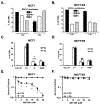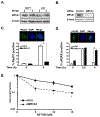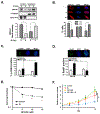Synthetic Lethality of PARP Inhibition and Ionizing Radiation is p53-dependent
- PMID: 29592899
- PMCID: PMC6713455
- DOI: 10.1158/1541-7786.MCR-18-0106
Synthetic Lethality of PARP Inhibition and Ionizing Radiation is p53-dependent
Abstract
PARP inhibitors (PARPi) are potentially effective therapeutic agents capable of inducing synthetic lethality in tumors with deficiencies in homologous recombination (HR)-mediated DNA repair such as those carrying BRCA1 mutations. However, BRCA mutations are rare, the majority of tumors are proficient in HR repair, and thus most tumors are resistant to PARPi. Previously, we observed that ionizing radiation (IR) initiates cytoplasmic translocation of BRCA1 leading to suppression of HR-mediated DNA repair and induction of synthetic PARPi lethality in wild-type BRCA1 and HR-proficient tumor cells. The tumor suppressor p53 was identified as a key factor that regulates DNA damage-induced BRCA1 cytoplasmic sequestration following IR. However, the role of p53 in IR-induced PARPi sensitization remains unclear. This study elucidates the role of p53 in IR-induced PARPi cytotoxicity in HR-proficient cancer cells and suggests p53 status may help define a patient population that might benefit from this treatment strategy. Sensitization to PARPi following IR was determined in vitro and in vivo utilizing human breast and glioma tumor cells carrying wild-type BRCA1 and p53, and in associated cells in which p53 function was modified by knockdown or mutation. In breast and glioma cells with proficient HR repair, IR-induced BRCA1 cytoplasmic sequestration, HR repair inhibition, and subsequent PARPi sensitization in vitro and in vivo was dependent upon functional p53.Implications: Implications: p53 status determines PARP inhibitor sensitization by ionizing radiation in multiple BRCA1 and HR-proficient tumor types and may predict which patients are most likely to benefit from combination therapy. Mol Cancer Res; 16(7); 1092-102. ©2018 AACR.
©2018 American Association for Cancer Research.
Conflict of interest statement
Figures






Similar articles
-
Nitric oxide-donor/PARP-inhibitor combination: A new approach for sensitization to ionizing radiation.Redox Biol. 2019 Jun;24:101169. doi: 10.1016/j.redox.2019.101169. Epub 2019 Mar 15. Redox Biol. 2019. PMID: 30889466 Free PMC article.
-
Synthetic Lethality of PARP Inhibitors in Combination with MYC Blockade Is Independent of BRCA Status in Triple-Negative Breast Cancer.Cancer Res. 2018 Feb 1;78(3):742-757. doi: 10.1158/0008-5472.CAN-17-1494. Epub 2017 Nov 27. Cancer Res. 2018. PMID: 29180466 Free PMC article.
-
An Effective Epigenetic-PARP Inhibitor Combination Therapy for Breast and Ovarian Cancers Independent of BRCA Mutations.Clin Cancer Res. 2018 Jul 1;24(13):3163-3175. doi: 10.1158/1078-0432.CCR-18-0204. Epub 2018 Apr 3. Clin Cancer Res. 2018. PMID: 29615458 Free PMC article.
-
Therapeutic targeting and patient selection for cancers with homologous recombination defects.Expert Opin Drug Discov. 2017 Jun;12(6):565-581. doi: 10.1080/17460441.2017.1322061. Epub 2017 May 2. Expert Opin Drug Discov. 2017. PMID: 28425306 Review.
-
Use of poly ADP-ribose polymerase [PARP] inhibitors in cancer cells bearing DDR defects: the rationale for their inclusion in the clinic.J Exp Clin Cancer Res. 2016 Nov 24;35(1):179. doi: 10.1186/s13046-016-0456-2. J Exp Clin Cancer Res. 2016. PMID: 27884198 Free PMC article. Review.
Cited by
-
PARP1 inhibitor (PJ34) improves the function of aging-induced endothelial progenitor cells by preserving intracellular NAD+ levels and increasing SIRT1 activity.Stem Cell Res Ther. 2018 Aug 23;9(1):224. doi: 10.1186/s13287-018-0961-7. Stem Cell Res Ther. 2018. PMID: 30139380 Free PMC article.
-
The role of poly(ADP-ribose) polymerase inhibitors in the treatment of cancer and methods to overcome resistance: a review.Cell Biosci. 2020 Mar 11;10:35. doi: 10.1186/s13578-020-00390-7. eCollection 2020. Cell Biosci. 2020. PMID: 32180937 Free PMC article. Review.
-
Small-Molecule Poly(ADP-ribose) Polymerase and PD-L1 Inhibitor Conjugates as Dual-Action Anticancer Agents.ACS Omega. 2019 Jul 24;4(7):12584-12597. doi: 10.1021/acsomega.9b01106. eCollection 2019 Jul 31. ACS Omega. 2019. PMID: 31460379 Free PMC article.
-
Inactivation of the tumor suppressor p53 by long noncoding RNA RMRP.Proc Natl Acad Sci U S A. 2021 Jul 20;118(29):e2026813118. doi: 10.1073/pnas.2026813118. Proc Natl Acad Sci U S A. 2021. PMID: 34266953 Free PMC article.
-
PARP inhibitor resistance: the underlying mechanisms and clinical implications.Mol Cancer. 2020 Jun 20;19(1):107. doi: 10.1186/s12943-020-01227-0. Mol Cancer. 2020. PMID: 32563252 Free PMC article. Review.
References
-
- Farmer H, McCabe N, Lord CJ, et al. Targeting the DNA repair defect in BRCA mutant cells as a therapeutic strategy. Nature 2005;434: 917–21. - PubMed
-
- Malone KE, Daling JR, Neal C, et al. Frequency of BRCA1/BRCA2 mutations in a population-based sample of young breast carcinoma cases. Cancer 2000;88: 1393–402. - PubMed
Publication types
MeSH terms
Substances
Grants and funding
LinkOut - more resources
Full Text Sources
Other Literature Sources
Medical
Research Materials
Miscellaneous

